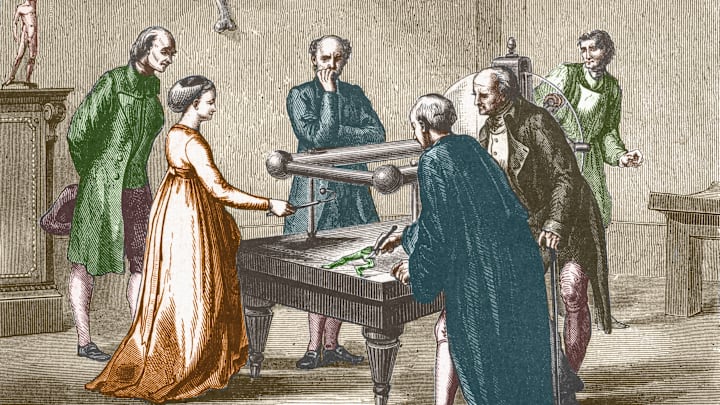Was there a real Dr. Frankenstein? Mary Shelley’s Frankenstein, or The Modern Prometheus is considered by many to be the first science fiction novel. It was written in 1816 and 1817, during a time when bringing the dead back to life was a serious endeavor in scientific circles.
Mary Wollstonecraft Shelley (née Godwin) wrote the book as an exploration of the ethics of such experimentation. She and her future husband Percy Shelley were staying with Lord Byron and other friends at a villa on Lake Geneva when the idea of the novel came to her, undoubtedly influenced by the discussions among the group. The model for the character of Dr. Frankenstein could have been one of more actual people of the time, whose unorthodox scientific investigations explored the nature of life and death. Here are some possible inspirations.
- Erasmus Darwin
- Giovanni Aldini
- Henry Cline
- James Lind
- Christian Gottlieb Kratzenstein
- Johann Conrad Dippel
- Paracelsus
Erasmus Darwin
Erasmus Darwin (grandfather of Charles Darwin) was a friend of Mary Shelley’s father, William Godwin. Shelley mentioned Darwin in the preface to her novel. He studied galvanism, the contraction of muscles when stimulated with electricity. Shelley mentions that Darwin “preserved a piece of vermicelli in a glass case, till by some extraordinary means, it began to move with voluntary motion." (She actually misremembered the name of the organism: it was Vorticella, a genus of microscopic sessile animals.)
The term galvanism came from the work Luigi Galvani, who discovered the phenomenon he called animal electricity. The term was coined by his contemporary Alessandro Volta, who invented the battery.
Giovanni Aldini
Giovanni Aldini was a nephew of Luigi Galvani. In 1803, he staged a public demonstration of galvanism at the Royal College of Surgeons in London using the body of murderer George Forster shortly after he was executed. Aldini was able to make the corpse’s face grimace and the arms and legs flex violently by applying electrodes connected to a battery.
Henry Cline
Henry Cline had been Mary Shelley’s doctor at one time. Cline made the newspapers in 1814 by reviving a sailor who had been in a coma for months. The act may have impressed the future author.
James Lind
Dr. James Lind was a friend to and influence on Percy Shelley. Although Lind is best known for discovering the cure for scurvy, he also experimented with animal electricity, in which he animated dead frogs by applying electrical currents to the muscles.
Christian Gottlieb Kratzenstein
Christian Gottlieb Kratzenstein could have been an inspiration for the name of Dr. Frankenstein. Kratzenstein began experimenting on the effects of electricity on the human body in 1744, too early to have had any direct contact with Mary Shelley, but she may have been familiar with his work.
Johann Conrad Dippel
Another possible influence on Shelley may have been Johann Conrad Dippel. Dippel was born at Castle Frankenstein in Germany in 1673, and made an effort to buy the castle later in life. Dippel was a theologian who became an alchemist and then a medical doctor. He produced a cure-all called Dippel's Animal Oil. He may have robbed graves for experiments in creating artificial life, but there is no concrete evidence.
Paracelsus
In the novel, Victor Frankenstein mentions that he studied the works of Paracelsus. Born Phillip von Hohenheim in 1493, Paracelsus entered college at age 16 already equipped with knowledge of alchemy. He claimed to have developed a homunculus, a microscopic yet fully formed man, from semen alone.
Read More About Science:
A version of this story was originally published in 2008 and has been updated for 2025.
